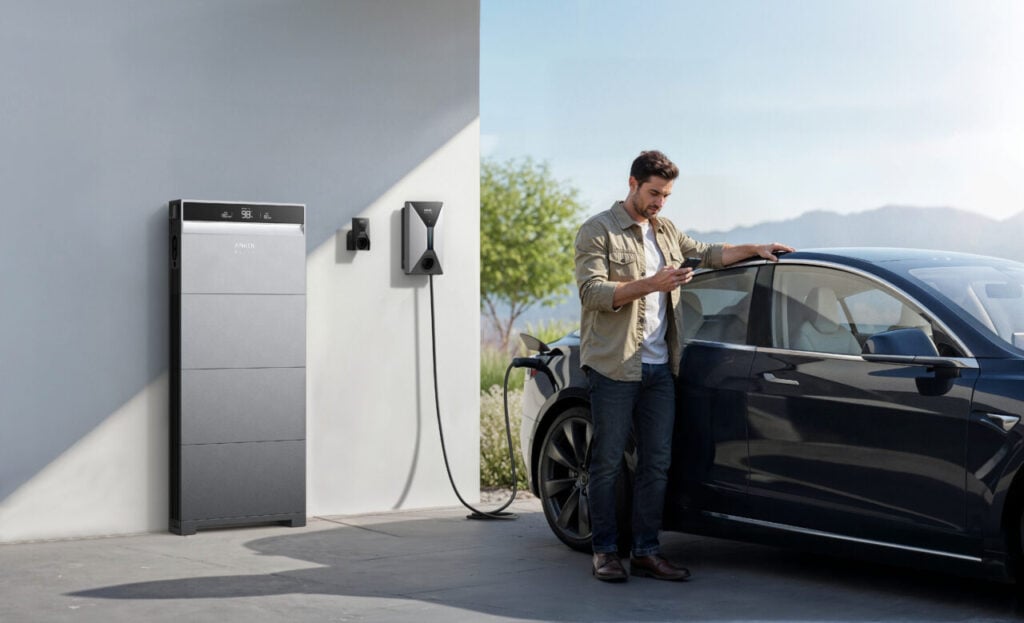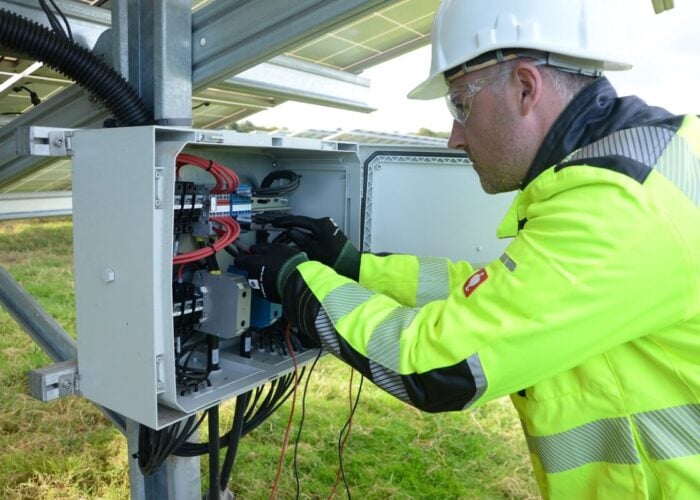
As Australia continues its transition toward renewable energy and electrification, international technology companies are recognising the unique opportunities and challenges presented by the continent’s distinctive geography and energy needs.
To find out more, PV Tech speaks with Symons Xie, general manager of Anker SOLIX APAC, at All-Energy Australia 2025, where the organisation outlined its strategy for establishing a major presence in Australia’s rapidly growing home battery and energy storage market.
Try Premium for just $1
- Full premium access for the first month at only $1
- Converts to an annual rate after 30 days unless cancelled
- Cancel anytime during the trial period
Premium Benefits
- Expert industry analysis and interviews
- Digital access to PV Tech Power journal
- Exclusive event discounts
Or get the full Premium subscription right away
Or continue reading this article for free
How has Anker SOLIX specifically adapted its battery technology to handle Australia’s extreme environmental conditions, particularly the intense heat and coastal corrosion challenges that can impact energy storage systems?
I think that’s one of the biggest challenges for the Australian market, especially because we have very long coastlines. All the major cities, including Melbourne, Sydney, Perth, and Brisbane, face the ocean along the eastern coastline, and even the west coast.
In this scenario, we believe you may encounter numerous corrosion issues. For other competitors, it is very challenging to install systems within 500 meters or even 1 kilometre away from the coastline because they will experience corrosion. From a long-term perspective, because batteries normally come with a 5-10 year warranty, they can hardly withstand the harsh coastal environment.
We have a special coating on the surface that allows our batteries to withstand these conditions much better. We hold the C5 marine level anti-corrosion rating, the highest rating available on the market. We identified this as one of the key needs for Australian residents, so we embedded that technology into our products.
Another advantage is that our batteries exhibit excellent performance in high temperatures. They will not degrade when the temperature goes up as high as 55 degrees Celsius – they will still output at 100% capacity. For other batteries, typically, when reaching this temperature, performance decreases rapidly, resulting in power loss for consumers.
Therefore, for these two scenarios, our company has inherent advantages embedded in our technology.
Can you explain how Anker SOLIX’s ‘Proven Globally, Trusted Locally’ positioning translates into concrete actions in the Australian market, and what this means for your long-term commitment to local partners and customers?
I know the very first thing people consider when selecting a battery is that it’s a 10-year product with a warranty. So, one of the most important things is to select the right brand.
Anker actually started our business in 2011, so we have been in operation for over 15 years. Anker also have a solid presence in Australia, having started doing business there in 2019. Anker SOLIX has over 16 local employees covering various business lines. Anker SOLIX are also heavily investing in service engineers to cover all the needs of our customers and retailers.
Especially at this exhibition, many installers may ask for help from Anker. With our locally based service engineers, we can provide very responsive support to the retailers and installers.
We want to do this in a very steady way. We don’t want to rush and fully rely on distributors to provide all the support to customers. We want to do it ourselves, and all these technical services are based in Australia with English-speaking staff, not in Indonesia, India, or other countries.
That is our strategy. We aim to build the business from the ground up and provide fundamental benefits to our customers. That is one of our strategies based in Australia. Of course, first and foremost, we are a long-established company. We also have a strong presence in Australia, providing reliable support to the industry and our customers.
What has driven Anker SOLIX’s performance in Australia this year, particularly regarding your participation in the Cheaper Home Battery initiative, and how do you measure success in terms of local market engagement?
I see that as a new brand – I mean Anker SOLIX as a new category brand introduced to Australia by Anker Innovations – we are really climbing up very quickly. According to Solar Quotes, a well-known third-party review platform, we have currently climbed to number five among battery brands rated by customers. We are growing rapidly, and the results are very promising.
In terms of installed volume, we also have thousands of systems already in place. I think we are on the right track, and the reason behind this is due to some of the strategies we are pursuing. I think it’s very long-term focused, not short-term.
Similar to the investment I mentioned in the service domain, we are investing heavily because when we entered this business, we quickly established our office in Sydney. Not many brands do that because it requires a significant upfront investment. We aim to establish long-term business relationships, which is why we opened our office there and hired a large number of local employees.
We even opened our own three warehouses in Australia – in Sydney, Perth, and Melbourne. Most brands coming to Australia rely on distributors’ warehouses. We built our own warehouses. All these moves demonstrate our long-term commitment to Australia.
Additionally, with the product itself, we are continually improving to take advantage of the affordable home battery program, which offers a substantial rebate. We are striving to maximise the benefits of the program to deliver the highest value to consumers.
For marketing purposes, we’re also supporting the industry. We are trying to introduce the product to many families. We are engaging with extraordinary retailers and have donated systems to the community. We have jointly donated systems to many surf clubs in Queensland. In the future, we will continue to donate a large number of systems – probably a huge number of systems will be donated freely, together with our retail partners.
We aim to give back to the community as a responsible company with long-term objectives, rather than focusing on short-term financial gains.
Could you share details about some of your recent developments in Australia and what you have learned about performance requirements and customer expectations in this market?
I think we are acting very responsibly and responding to the needs and requirements of the Australian people. For example, the home backup power solution we introduced at this exhibition is progressing rapidly in terms of external research and internal R&D development, aiming to meet the requirements of Australian families.
That is one of the things we are doing, as home backup has become a key requirement for consumers here.
Especially, we understand that in some areas of Queensland, including North Queensland, they’re suffering from numerous storms and natural disasters. We are definitely going to meet those customers’ requirements and provide them with value.
We can also support solar power generators and all this equipment to help them survive even three days, even seven days, in those harsh environments. I think this is really important.
Anker is a consumer company, and we really listen to consumers. We have a system called VOC (Voice of Customer) where we collect a lot of feedback from consumers. Globally, at Anker, we have approximately 300 employees working in the Customer Experience Department.
They deal with consumers daily, so they’re collecting all this feedback to help us improve the consumer experience and deliver extraordinary value to customers.
What comprehensive upgrades have you made to the X1 home energy solution specifically for Australian households, and how do features like the Smart EV Charger and whole-home backup integrate with local energy usage patterns?
This is also a very important question, as electrification is becoming increasingly mainstream. Everybody is using a lot of EVs, electric water heaters, and all these things that consume electricity. So the requirements for electricity are surging. Additionally, I believe the recent rebate program is encouraging everyone to install larger batteries.
For Anker, when we introduced the EV charger as part of our X1 ecosystem, it can really help users and consumers have a very unified experience. Right before, I would say that maybe the batteries were from brand A, the inverters from brand B, and the solar panels from brand C. However, we’re currently working to consolidate all our services and provide a unified app for monitoring everything.
Additionally, for home backup, as I mentioned earlier, we’re trying to meet the requirements of the Australian people. Although some areas, such as Sydney or Melbourne, don’t experience power blackouts very often, we still offer this option to consumers. We’re quickly making that product available early next year, probably by the end of February. We’re testing in January and releasing in February.
How does Anker SOLIX’s Virtual Power Plant integration capability work in practice for Australian customers, and what role do you see this playing in supporting the country’s transition to more sustainable energy systems?
We are very proud to have had a signing ceremony at lunchtime today with Amber Electric and Origin Energy. These are key Virtual Power Plant players in the market, allowing us to provide added value to Anker’s hardware.
Our philosophy is to provide value-added products and services to consumers, encompassing not only hardware but also partner services. This actually includes retailers, value-added consultation, design, and after-sales service as part of the overall customer experience journey. That’s the kind of thing we want to do.
With the VPP-ready X1, I believe it can greatly benefit many consumers.






